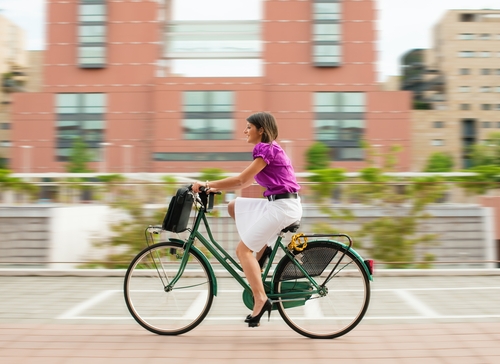By ACSM
When we talk about “building healthy communities,” we don’t just mean improving the overall level of health and fitness of our fellow citizens. We mean, literally, building – as in, shovels, bricks, sod and structures. The built environment has much to do with how fit we are. How fit is your community?
Are there bike lanes so you can safely commute to work? Bike racks on buses and at your destination? Does your town have a series of parks within a quick walk for families? Can kids walk safely to school? If you live or work on a campus of buildings, are there places to walk and play outside?
Fitness is more than exercise classes or team sports. Our activities of daily living can add up to many minutes of healthy exercise, helping us regularly reach levels recommended in the federal guidelines. The opportunities vary from one community to another. While one region may have trails for cross-country skiing, another offers pocket parks. Zoning requirements may call for sidewalks for new construction or redevelopment. A closed school may become a community center with ballparks and playgrounds. It takes a fit community to create a fit population. The time to act is now!
The (Link Removed) includes strategies to encourage measures such as active transportation, many of which involve land-use planning, economic development, infrastructure choices and public policy. Some of these are large-scale, public undertakings involving networks of greenways and trails. Other efforts are within reach for small groups to accomplish. Many times, volunteers have built a playground over a weekend or turned abandoned lot into playground.

The old mantra “Think globally, act locally” applies here. We can take steps as individuals and groups while pursuing more comprehensive approaches. Examples of the latter include:
- Incentives to locate public facilities (such as schools and post offices) within convenient walking distance of major residential areas
- Adoption of “Complete Street” standards to encourage roadways amenable to those on foot, on bicycle or using wheelchairs
- Support for active transportation programs such as Safe Routes to School and Bike-to-Work
- Integrated development standards that incorporate land-use, transportation, community design, parks, trails and greenways, and economic development planning
- Adoption of Crime Prevention Through Environmental Design to enhance personal safety and increase physical activity
Meanwhile, there are opportunities in every community to make active lifestyles more accessible. It starts with taking a creative look at the world around us and a desire to help our families and fellow citizens achieve better health through activities of daily living. If you skip the office elevator or park in the out-lot to get in a few more steps, why not begin a workplace wellness program? Can you look into a Walking School Bus program at your neighborhood school? What would it take to a create a pocket park in the vacant lot down the street? The American College of Sports Medicine has developed the American Fitness Index, which you can use to rate your community’s support for active lifestyles and healthy residents.
Exercise your imagination and see what opportunities you can create.
What can you do to work toward a built environment that encourages more active lifestyles in your community?